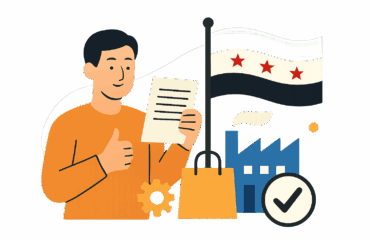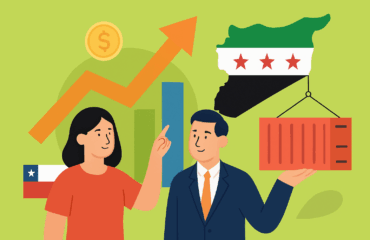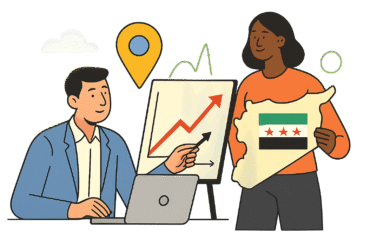
SWOT Analysis of the Syrian Market Today: Opportunities, Challenges, and Strengths to Exploit
- Entering any new market requires a deep and precise understanding of its environment.
- Syria has numerous strengths that can be leveraged for business growth.
- Current challenges include economic, infrastructure, and political and security stability.
- Reconstruction and development present a significant opportunity for investors.
- Success in the Syrian market requires clear and flexible strategies.
Table of Contents
- First: Analysis of Strengths
- Second: Analysis of Weaknesses
- Third: Analysis of Opportunities
- Fourth: Analysis of Threats
- Proposed Strategies
- Insight Syria’s Role in Supporting Investors
- Conclusion
First: Analysis of Strengths (Strengths)
Despite challenges, Syria possesses many intrinsic strengths that can be a strong foundation for business growth.
- Strategic Geographical Location: Syria enjoys a unique geographical location as a crossroads of historical trade routes between Asia and Europe.
- Young and Educated Workforce: Syria is characterized by a high percentage of young, educated people capable of quick learning.
- Basic Infrastructure (Remaining): Parts of the basic infrastructure are still operational and can be rehabilitated.
- Natural Resources: Syria has diverse natural resources, including fertile agricultural land.
- Large Local Market (Though Affected): Syria still has a relatively large consumer market.
Second: Analysis of Weaknesses (Weaknesses)
Weaknesses are the internal challenges facing the market that need to be effectively addressed.
- Deteriorating Economic Conditions: The Syrian economy suffers from high inflation.
- Damaged Infrastructure: Rehabilitating infrastructure requires massive investments.
- Lack of Political and Security Stability: Safety concerns hinder investment.
- Regulatory and Bureaucratic Constraints: Companies face difficulties with complex regulatory procedures.
- Lack of Capital and Financing: Investors struggle to access necessary funding.
- Economic Sanctions Impact: Sanctions directly impact trade.
Third: Analysis of Opportunities (Opportunities)
Opportunities are the positive external factors that can be leveraged for growth.
- Reconstruction and Development: There is an urgent need for infrastructure reconstruction.
- Investing in the Renewable Energy Sector: This sector can provide a promising opportunity.
- Agricultural Sector and Food Industries Development: The agricultural sector can be updated using modern technologies.
- Investment in Technology and Communications: There is a growing demand for technological solutions.
- Tourism (Selectively): Tourist sites can be exploited to attract certain types of tourism.
- Facilitating Business Environment: There is an opportunity to encourage the government to simplify procedures.
Fourth: Analysis of Threats (Threats)
Threats include negative external factors that may impede success.
- Continued Political and Security Instability: Any escalation of crises may jeopardize investments.
- Deterioration of Global and Regional Economic Conditions: Being affected by crises may impact demand.
- Continued or Increased Economic Sanctions: They may further complicate business operations.
- Logistical and Transport Challenges: Companies face difficulties in importing materials.
- Unfair or Unregulated Competition: It may affect the fairness of competition.
- Trust Rebuilding Challenges: Investors need to build trust in the market.
Proposed Strategies to Confront Challenges and Seize Opportunities
Based on the SWOT analysis, multiple strategies can be proposed for investors and companies operating in the Syrian market.
- Strengths + Opportunities Strategies (SO Strategies):
- Utilize the geographical location for reconstruction.
- Develop the workforce for promising sectors.
- Leverage natural resources in rehabilitation.
- Weaknesses + Opportunities Strategies (WO Strategies):
- Strategic partnerships to overcome constraints.
- Adaptation to the regulatory environment.
- Use technology to mitigate the negative impact of infrastructure.
- Strengths + Threats Strategies (ST Strategies):
- Diversify revenue sources.
- Build strong relationships with governmental and local entities.
- Weaknesses + Threats Strategies (WT Strategies):
- Avoid high-risk areas.
- Focus on defensive strategies.
- Prepare for emergencies.
Insight Syria’s Role in Supporting Investors
At “Insight Syria,” we are committed to providing the analytical tools and accurate data investors need to build their strategies.
- Specialized Market Research: Provide in-depth data on consumer behavior.
- Policy and Regulatory Environment Analysis: Help companies understand the legal framework.
- Public Opinion Measurement: Conduct surveys to understand community perceptions.
- Big Data Analysis: Use data analysis tools to extract actionable insights.
- Strategic Consulting Services: Provide expert advice to help make informed investment decisions.
Conclusion
The Syrian market today represents both a challenge and an opportunity. Success requires a deep understanding of the reality, adaptability, and a clear strategic vision.
At “Insight Syria,” we are your partners in exploring this complex market, always ready to provide you with the knowledge and data required to succeed.
Frequently Asked Questions (FAQ)
The main strengths include the strategic geographical location, young workforce, and diverse natural resources.
Opportunities can be exploited by investing in reconstruction and development, sectors such as renewable energy and agriculture.
Threats include political and economic instability, economic sanctions, and logistical challenges.
Weaknesses can be overcome through strategic partnerships, understanding the regulatory environment, and using technology.



